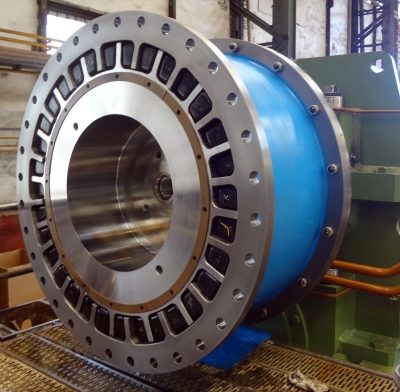Regal Power Transmission Launches Torque-Amplification Analysis Program

Regal Power Transmission Solutions (PTS) has launched a torque-amplification measurement and analysis program for precisely measuring the true torque loads and vibration frequencies experienced by rolling mill drives, as part of a program to help mills process tougher alloys, increase output with thicker slabs or higher speeds, protect against cold-end slabs, or mitigate torsional vibration. Developed under Regal’s Kop-Flex brand, the Perceptive Technologies TqM torque amplification analysis program combines computer modeling of complex drives with true torque measurements to determine the actual torque amplification factor (TAF) on the drive, instead of inferring it from motor current readings. Kop-Flex then engineers solutions that reduce TAF and torsional vibration using alterations of coupling stiffness, improved overload protection, resilient couplings and other strategies.
"TAF can be defined as the peak torque divided by the rolling torque," explained Chris Carrigan, director of application engineering and lifecycle services at Regal PTS. "It's a unit-less factor that illustrates the severity of a torque spike in terms of magnitude. It is affected by system dynamics or how the inertias and stiffnesses are distributed across a complex drivetrain. Entry conditions, such as slab temperature, speed, angular clearances and backlash in gear components all play a role. The old rule of thumb for mill drives was to keep the TAF under 2.5, but with motor sizes increasing, slab thickness increasing and new alloys being processed, the old rules don't apply. As rolling torque increases, so will peak torque, degrading overload protection devices, bearings, couplings, work rolls, etc. Often the first sign of a torsional problem is equipment failure."
TAF analysis applies measured torque readings to 3D mode shape analysis to visualize how a drive train twists at various locations to determine where to alter stiffness or increase damping. "We use torque monitoring hardware developed by Regal Kop-Flex for high-speed turbomachinery drives, so it is already mill-hardened, accurate and capable of high-rate data sampling," said Carrigan. "High-rate sampling using strain gages allows the system to capture momentary torque spikes that would normally be unseen on motor current readings because of the high-inertia in these drives. At lower sampling rates, peak torque measurements are often truncated because the system cannot capture them. High-rate sampling is a must to capture these events in a complex, high-inertia drive."
According to Carrigan, Kop-Flex has used the technology to engineer TAF reductions as high as 50 percent. TAF data capture and analysis can be a temporary service or it can be integrated with a mill's condition monitoring system as an ongoing service. Regal PTS offers Perceptive Technologies condition monitoring equipment and diagnostics for the steel industry to track bearing vibration, temperature and other data. Additional data on torque loads allows the mill to correlate the measured torque with slab temperature, force on the work rolls, speed, gap, etc., so engineers can better understand the root cause and make needed changes on scheduled downtime, before cumulative damage leads to an unscheduled outage.





